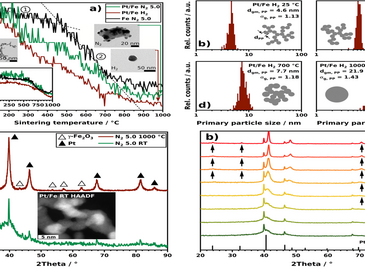Vinzent Olszok, Philipp Rembe, Tim Grieb, Eshan J. Wijeyeratnam, Andreas Rosenauer, Alfred P. Weber
Nanoscale Advances 6(15) 2024: 3895-3903
https://doi.org/10.1039/D4NA00276H
Spark ablation was used to continuously synthesize bimetallic L10 Pt/Fe nanoparticles in an aerosol process involving a furnace and hydrogen as a reducing process gas. For the formation of Pt/Fe in the favorable L10 crystal configuration, which is a promising electrocatalyst, the Pt–Fe ratio plays a crucial role. State-of-the-art analytics for such multi-element nanoparticles include, among others, electron microscopy (EM) with an element mapping function, such as scanning transmission electron microscopy with energy-dispersive X-ray spectroscopy (STEM-EDXS). Morphological characteristics, local compositions, and element distributions within single particles can be easily derived from EM for a small number of particles. However, a statistical evaluation aiming at the composition of hundreds of single Pt/Fe particles can barely be addressed with such analytics. Driven by the lack of analytical setups aiming at the recording of composition and size distribution of nanoparticles by online diagnostics, this work focuses on a single-particle inductively coupled plasma mass spectrometry (spICP-MS) setup able to resolve this issue. The combination of nanoparticle dilution and classification with spICP-MS allows for the analysis of thousands of multi-element aerosol nanoparticles within minutes. Hence, this article elaborates on the synergy of conducting STEM-EDXS and spICP-MS measurements in parallel, giving the opportunity to multi-dimensionally characterize nanoparticles consisting of more than one element. Beyond metallic particles, the presented setup even allows for the analysis of hetero-aggregated oxidic particles, such as Pt/Fe2O3. Including further offline analytics like X-ray diffraction (XRD), the formation of L10 Pt/Fe was found to be process gas-dependent and to set in at 400 °C, yielding particles with 56% L10 content at 1000 °C under a reducing atmosphere.


